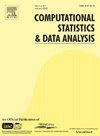Bayesian forecasting of Italian seismicity using the spatiotemporal RETAS model
IF 1.6
3区 数学
Q3 COMPUTER SCIENCE, INTERDISCIPLINARY APPLICATIONS
引用次数: 0
Abstract
Spatiotemporal Renewal Epidemic Type Aftershock Sequence models are self-exciting point processes that model the occurrence time, epicenter, and magnitude of earthquakes in a geographical region. The arrival rate of earthquakes is formulated as the superposition of a main shock renewal process and homogeneous Poisson processes for the aftershocks, motivated by empirical laws in seismology. Existing methods for model fitting rely on maximizing the log-likelihood by either direct numerical optimization or Expectation Maximization algorithms, both of which can suffer from convergence issues and lack adequate quantification of parameter estimation uncertainty. To address these limitations, a Bayesian approach is employed, with posterior inference carried out using a data augmentation strategy within a Markov chain Monte Carlo framework. The branching structure is treated as a latent variable to improve sampling efficiency, and a purpose-built Hamiltonian Monte Carlo sampler is implemented to update the parameters within the Gibbs sampler. This methodology enables parameter uncertainty to be incorporated into forecasts of seismicity. Estimation and forecasting are demonstrated on simulated catalogs and an earthquake catalog from Italy. R code implementing the methods is provided in the Supplementary Materials.
利用时空RETAS模型对意大利地震活动性的贝叶斯预测
时空更新流行型余震序列模型是一种模拟地理区域内地震发生时间、震中和震级的自激点过程。根据地震学的经验规律,将地震的到达率表示为主震更新过程和余震的均匀泊松过程的叠加。现有的模型拟合方法依赖于通过直接数值优化或期望最大化算法来最大化对数似然,这两种方法都存在收敛问题,并且缺乏对参数估计不确定性的充分量化。为了解决这些限制,采用贝叶斯方法,并在马尔可夫链蒙特卡罗框架内使用数据增强策略进行后验推理。将分支结构作为潜在变量处理以提高采样效率,并实现了专用的哈密顿蒙特卡罗采样器来更新吉布斯采样器内的参数。这种方法可以将参数的不确定性纳入地震活动性的预测中。以模拟地震目录和意大利地震目录为例进行了估计和预报。在补充资料中提供了实现这些方法的R代码。
本文章由计算机程序翻译,如有差异,请以英文原文为准。
求助全文
约1分钟内获得全文
求助全文
来源期刊

Computational Statistics & Data Analysis
数学-计算机:跨学科应用
CiteScore
3.70
自引率
5.60%
发文量
167
审稿时长
60 days
期刊介绍:
Computational Statistics and Data Analysis (CSDA), an Official Publication of the network Computational and Methodological Statistics (CMStatistics) and of the International Association for Statistical Computing (IASC), is an international journal dedicated to the dissemination of methodological research and applications in the areas of computational statistics and data analysis. The journal consists of four refereed sections which are divided into the following subject areas:
I) Computational Statistics - Manuscripts dealing with: 1) the explicit impact of computers on statistical methodology (e.g., Bayesian computing, bioinformatics,computer graphics, computer intensive inferential methods, data exploration, data mining, expert systems, heuristics, knowledge based systems, machine learning, neural networks, numerical and optimization methods, parallel computing, statistical databases, statistical systems), and 2) the development, evaluation and validation of statistical software and algorithms. Software and algorithms can be submitted with manuscripts and will be stored together with the online article.
II) Statistical Methodology for Data Analysis - Manuscripts dealing with novel and original data analytical strategies and methodologies applied in biostatistics (design and analytic methods for clinical trials, epidemiological studies, statistical genetics, or genetic/environmental interactions), chemometrics, classification, data exploration, density estimation, design of experiments, environmetrics, education, image analysis, marketing, model free data exploration, pattern recognition, psychometrics, statistical physics, image processing, robust procedures.
[...]
III) Special Applications - [...]
IV) Annals of Statistical Data Science [...]
 求助内容:
求助内容: 应助结果提醒方式:
应助结果提醒方式:


